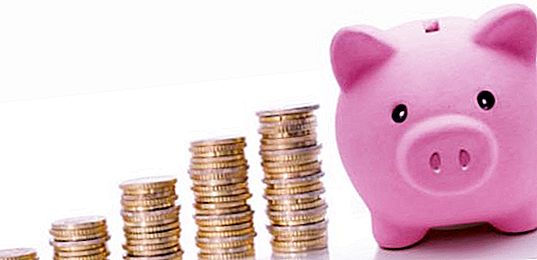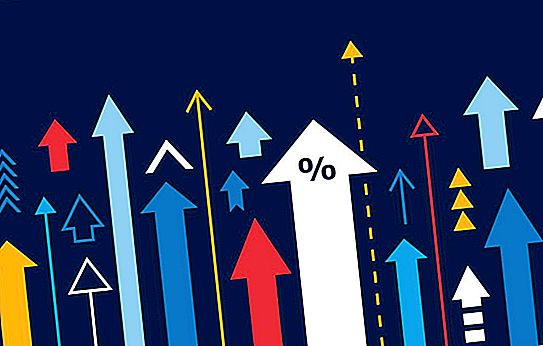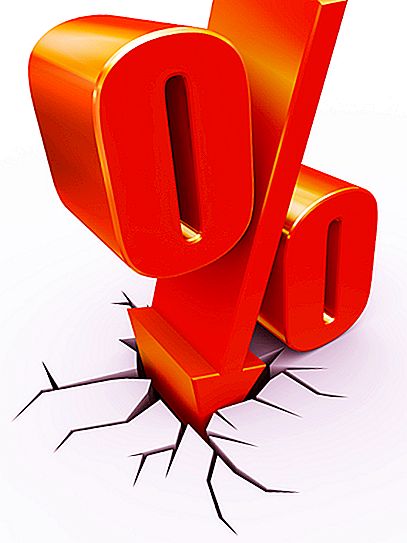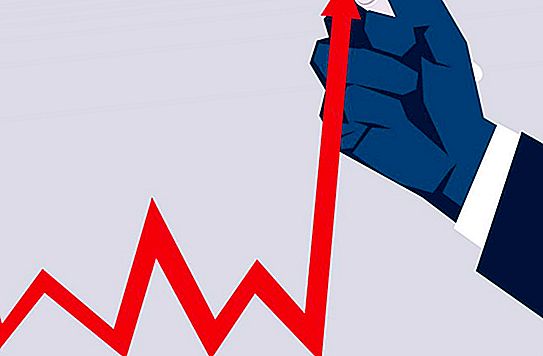In the conditions of an unstable economic situation or crisis, they often talk about inflation and deflation. The term “inflation” can be heard on the market and in public transport, in a store and office, everyone uses it in his speech: from an advanced economist to a simple worker at a factory. One can only guess what meaning different people put into the concept of inflation. Most often you hear that she is the "culprit" of almost all the troubles in the country's economy. Is it so?
And what is deflation? Is it good or bad? What is better for economic development? This is what will be sorted out in this article, where the concepts of these processes, their types, causes and consequences that make up inflation will be disclosed.
Inflation. What it is?

Inflation is a process of losing the value of money, i.e., reducing their purchasing power. Simply put, if last year for 100 rubles you could buy 5 rolls of bread, then this year for the same 100 rubles you can buy only 4 rolls of the same bread.
In different periods of time, this process may concern different industries and different groups of goods. The inflation process consists in the fact that the total amount of money in circulation and available from the population is greater than what you can buy goods in circulation from. This leads to an increase in prices for these goods, while household income remains the same. As a result, you can buy less and less goods with a specific amount of money over time.
Types of Inflation
Economists and financial analysts identify many gradations of inflation on various grounds. Here are some of them:
1. According to the level of regulation by the state, inflation can be hidden and open.
Hidden - there is tight state control over the price level, resulting in a shortage of goods, because producers and importers cannot sell their goods at prices that the government dictates. As a result, people have money, but nothing to buy. From under the floor, scarce goods are sold at inflated prices.
Open - there is an increase in prices for resources used in production, resulting in higher prices for manufactured goods.
2. According to the growth rate, moderate inflation, galloping and hyperinflation are distinguished.
Moderate - price increases do not occur sharply, slowly (up to 10% per year), but wage growth is growing even more slowly.
Galloping - high growth rates (11-200%). Such inflation is the result of serious violations by the monetary system. Money depreciates very quickly.
Hyperinflation is an extremely high rate, almost uncontrollable situation (from 201% per year). It causes extreme distrust of money, the transition to barter operations, to the payment of wages not in cash but in kind.
3. According to the degree of foresight, there is expected and unexpected inflation.
Expected - this is the projected inflation rate based on last year's experience and prevailing assumptions in the current period.
Unexpected - the value of which was higher than predicted.
4. In everyday life, inflation is still divided into official and real inflation. Official inflation is like "the average temperature in a hospital." To calculate the difference in the price level with a one-year interval, data are received for different sectors of the economy in all regions of the country, and then a weighted average is displayed. So it turns out that the goods and services that make up the bulk of the consumer basket (these are food, utilities, education, leisure, medicine, etc.) increased in price by 20%, oil - by 2%, gas - by 3%, the price of wood fell by 7%, etc. As a result, official inflation amounted to 4.5%. It is this value that will be taken into account when indexing wages. The real inflation is the one that is reflected in people's wallets. Based on this example, it would be 20%.
Reasons for inflation

Studying and analyzing the causes of inflation is a complex economic process. As a rule, the onset of the inflationary process is caused not by one reason, but several at once, while one may flow from the other, as in a chain. They can be external (consequences of state actions in the international arena) and internal (domestic economic processes). The main ones include:
1. Reducing the refinancing rate.
It is known that the Central Bank of the state lends money to credit organizations at a certain percentage. This percentage is the refinancing rate. And if the Central Bank reduces this rate, then credit organizations can give money to the population in the form of loans also at a lower percentage. The population takes more credit funds, which increases the amount of money in circulation. This is an internal reason.
2. The devaluation of the national currency.
This is the process when the country's national currency begins to fall in price relative to stable currencies. For a long period, it is the US dollar and the euro. When the ruble exchange rate falls, the cost of purchasing imported goods will inevitably increase, which means that their price for the consumer will increase. Even if the country's domestic markets have an offer for partial replacement of imported goods, then their price will only temporarily stay at the same level. This is due to the fact that imported raw materials, fuel, and components are often used to produce domestic goods. Therefore, prices for domestic goods will also rise. This is an external reason.
3. The imbalance of supply and demand in the domestic market of the state.
An excess of aggregate demand leads to the fact that production does not have time to supply, there is a shortage of goods, hence the price rises. Also, an excess of aggregate demand may be a consequence of a decrease in the production of goods, and this, in turn, is a consequence of an increase in the cost of imported raw materials, and the cost has increased due to the devaluation of the ruble. Thus, the external cause of inflation influenced the emergence of the internal one, and further their consequences will have a comprehensive development.
4. Emergencies or martial law in the state.
This entails unplanned unproductive expenses, misallocation of national income. Nothing is invested in the development of production and the state, and free money in circulation increases without increasing the goods that can be bought on them.
5. State budget deficit.
If a situation arises when expenses in the state exceed incomes, the state, in order to cover this deficit, begins to print money or sell debt securities to banks or the public. This leads to an increase in the amount of money in circulation, and the quantity of goods remains unchanged.
Deflation

What is deflation? In fact, this is the opposite of inflation.
In simple words, deflation is a decrease in the general level of prices for goods.
If, during inflation, goods and services rise in price, and the purchasing power of money falls, then during deflation, on the contrary, the prices of goods fall, and the purchasing power of money increases. That is, for 100 rubles yesterday you could buy 4 bread rolls, and today for the same 100 rubles you can buy 5 bread rolls.
It would seem, so what's wrong? This is very good for the population. Most people perceive deflation as a positive and very desirable process.
Reasons for deflation
1. The imbalance of supply and demand.
In a healthy economic situation, demand always creates supply. If the opposite happens, then a situation arises when more goods are produced and imported than the country's population can buy, therefore, prices for goods are reduced.
2. Expectant position of the population.
This reason is a direct consequence of the first reason. People are in no hurry to spend money, especially on large acquisitions, because they are waiting for the price to fall still. This leads to a further decrease in demand amid constant supply.
3. A sharp decrease in working cash in the fight against inflationary processes.
In simple words, this deflation replaces inflation. Such a situation arises when too harsh or excessive measures have been taken by the state to contain inflation. For example, suspension of growth of wages and pensions, increase of taxes and discount rate of the Central Bank, reduction of expenses on the budget sphere.
Consequences of opposing processes
It is known that there is such an opinion: inflation is negative, and deflation is a positive process. However, inflation and deflation have their consequences for the economic equilibrium of the state. Their list is long, and often one consequence gives rise to another. Moreover, they can be both negative and positive. The following are the main effects of inflation and deflation.
Consequences of inflation

Negative:
- Depreciation of savings, loans, securities, which entails distrust of the banking system, investment activity.
- Money ceases to fulfill its functions, barter appears, speculation increases.
- Decrease in employment.
- A decrease in the demand of the population for certain goods and services, which inevitably leads to a deterioration in living standards.
- The devaluation of the national currency.
- Decline in national production.
The positive consequences include the stimulation of economic activity and business activity, which leads to economic growth. However, this is a temporary phenomenon that can only persist with a controlled planned inflation rate.
Consequences of deflation

Negative:
- Decrease in consumer demand, or deferred demand. When people expect even greater price reductions and are in no hurry to purchase goods and services. Thus, prices fall even lower.
- A drop in production, which inevitably occurs after a drop in demand. What is the point of producing goods that are not being bought.
- The closure of companies, factories that can not "stay afloat" due to falling demand.
- Massive increase in unemployment due to bankruptcy of companies and reduction of staff remaining. From here follows a fall in incomes.
- Massive outflow of investments, which further exacerbates the situation in the country's economy.
- Many assets are depreciated.
- Banks stop lending to business and the public or give money at a fabulously high percentage.
It turns out a vicious circle and chaos in almost every area of economic activity, any state will need a lot of time and effort to get out of this state and balance the economy.
The positive aspects can only be attributed to temporary short-term euphoria from lower prices for goods and services.




